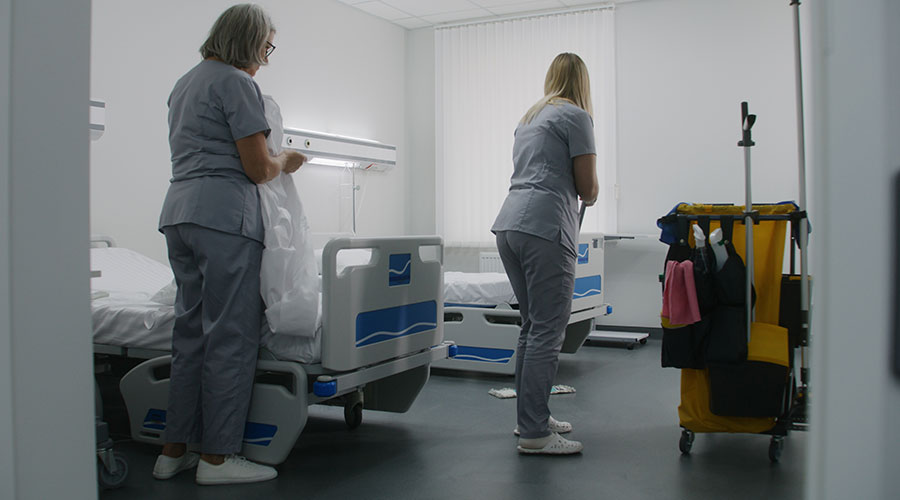Accredited healthcare organizations are familiar with the extensive amount of preparation required every three years in advance of the Joint Commission’s survey. One component of the Joint Commission’s survey determines a facility’s compliance with the Life Safety Code NFPA 101. Hiring a qualified architecture and engineering (A/E) firm to conduct a Life Safety Assessment and prepare for this aspect of the accreditation survey is the best way to ensure a smooth and successful process.
The life safety assessment: Process and deliverables
During a Life Safety Assessment, the A/E firm will conduct a thorough on-site review of the facility and assess compliance with the Life Safety Code. This includes examining egress paths, doors, stairways, and above-the-ceiling areas; noting the presence of smoke and fire dampers, smoke detectors, fire extinguishers, exit signs, and egress illumination devices; and reviewing fire-resistance ratings of doors and partitions.
Your A/E firm should designate a primary client contact to maintain regular and consistent communication with the healthcare organization throughout the entire process, from planning the visit to completing the final drawings that will be reviewed by the Joint Commission official during the survey inspection. The A/E firm should also hold frequent review meetings with your organization’s facility manager and safety officer, both before and after the on-site assessment. As part of the process, the A/E firm will gather building information from previously prepared Life Safety plans, owner’s record drawings, field assessments, Joint Commission surveys, and consult applicable building codes as determined by the facility’s year of construction.
It’s advisable as part of the Life Safety Assessment process to have the A/E firm prepare two deliverables: (1) Statement of Conditions (SOC) drawings, which the Joint Commission surveyor will review as part of the field inspection, and (2) a separate, “clean set” of Life Safety drawings for the healthcare organization’s day-to-day use. Both sets of graphics should be easy to read and clear in terms of both design and content. The use of linework with bold colors and clear labels makes the documents useful and easy to consult during daily operations as well as during official surveys.
Statement of conditions drawings
Statement of Conditions (SOC) drawings, which will be examined by the Joint Commission surveyor, should note any and all deficiencies that need to be corrected for Code compliance. To comply with Joint Commission Guidelines, a unique identifier will be assigned to each deficiency. Your A/E firm should prepare a Plan for Improvement to submit to the Joint Commission, setting forth a method for mitigating each deficiency.
Not all fire protection features and devices will be included on SOC drawings. Items that should be part of the on-site review but that are not required to be noted on SOC drawings include smoke detectors, fire pull-stations, fire extinguishers/cabinets, exit signs, and travel distances. These items are memorialized in field notes, which should be scanned and provided to the healthcare organization. If desired, the A/E firm can also prepare an additional, separate set of drawings for the facility that notes the locations of these features. But since they are not required for SOC drawings, they should be omitted in the interest of clarity.
Commissioning new SOC drawings for each survey is essential to making your Joint Commission survey go smoothly and efficiently. Up-to-date, accurate drawings make it easier for the surveyor to proceed with the inspection. Clear disclosure of any and all deficiencies assures the surveyor that you’re not hiding anything.
Life safety drawings for facility use
For day-to-day use by the healthcare organization, the A/E firm should also prepare a “clean set” of drawings that do not note the deficiencies for the Joint Commission. Organizations usually find clean drawings useful in daily operations and during visits by the fire marshal or representatives of other regulating bodies.
It’s advantageous for every healthcare organization to possess this type of clean, current, up-to-date set of floor plans and drawings. Yet it’s common for organizations to instead have older, outdated drawings. This can happen when a facility is renovated but floor plans and documents are not updated to reflect the changes made. Or, there may be inaccuracies in original or existing documents that were never corrected. The A/E firm should produce an up-to-date set of Life Safety drawings that includes, for example, clear representations of rated walls, egress stairs, and building exits; definitions of smoke compartments and fire protection (Approved Automatic Sprinkler System or AASS) coverage; and notations of sleeping vs. non-sleeping suites.
A more advanced, state-of–the-art way to capture this building information for a healthcare organization’s daily use is through the use of 3D software. There are many advantages to 3D models of buildings and building systems. They allow facility managers to quickly view and identify the location and type of each conduit, smoke and fire damper, smoke detector, and penetration through a fire-rated partition. The need to locate and review multiple drawings and spreadsheets is eliminated, as the model can incorporate information such as date of installation, age, and the maintenance record for each smoke and fire damper. Future technology of 3D modeling software may allow the model to be tied into the building automation system (BAS), interfacing with the mechanical and electrical systems and enabling staff to assess their functioning.
The 3D model can then be used a starting point for the use of Virtual Design and Construction (VDC) in future building expansions or renovations. Through VDC, the total project can be integrated into the existing building systems to ensure life safety code compliance.
Additional services: A “living document”
Forward-thinking healthcare organizations will go one step further and consult the A/E firm annually or semi-annually instead of just once every three years in relation to the Joint Commission survey. More frequent consultations will enable the organization to maintain a “living document” that provides an always-up-to-date representation of the facility. This more frequent review of the facility and its corresponding Life Safety drawings will reduce the amount of work needed every three years to prepare for the Joint Commission survey. In turn, it allows for more consistent budgeting by spreading the cost of preparing for the survey over three years.
The annual or semi-annual assessment should include an on-site walk-through but need not be as involved as an above-the-ceiling examination. The A/E firm should make sure the facility is still in compliance with the Life Safety Code and that its layout and features are still accurately reflected in floor plans and drawings. Revised drawings should be produced as needed.
Advantages of hiring a qualified A/E firm
For the tasks outlined above, best practices dictate hiring an A/E firm with extensive experience designing healthcare facilities and conducting building assessments. This ensures the most comprehensive review and minimizes or eliminates surprises during the accreditation survey. An experienced firm will be well versed in interpreting applicable current and historic building codes, spotting deficiencies, and providing innovative solutions. By understanding facility design from the patient care and staff workflow perspectives as well as with respect to Life Safety, the A/E firm can take a system-wide approach to ensure that proposed mitigations are cost-effective and minimally disruptive to patient care.
Continuing to use the same A/E firm for subsequent assessments and surveys is a wise practice when possible. That firm will have amassed knowledge about the building, will know which particular building code provisions are applicable, and will come to understand reasons behind various design decisions. Code officials rotate, so the individual conducting the Joint Commission survey may not be familiar with the history of the facility. It may be necessary in some situations for the healthcare organization to explain and even defend why various features are in compliance. Having an A/E firm that is knowledgeable about the building and knowledgeable about building codes applicable to healthcare facilities can be invaluable in such a situation.
Hiring and training qualified vendors and contractors
Healthcare organizations should ensure that vendors and contractors hired to renovate or work on the building understand how to maintain compliance with the Life Safety Code. Wall penetrations (e.g., when a cable, pipe, or duct penetrates a partition) may affect fire-resistance ratings and create deficiencies. A change in the use of a space (e.g., changing a patient room to a storage area) may bring with it a different set of Code requirements. Training vendors and contractors on Life Safety Code compliance on an annual basis is essential to maintaining Code compliance and avoiding surprises during the Joint Commission survey process.
Ryan Cousino, is a project lead/project manager at SSOE Group.

 Disinfectant Dispensers in Healthcare Facilities Often Fail to Deliver Safe Concentrations: Study
Disinfectant Dispensers in Healthcare Facilities Often Fail to Deliver Safe Concentrations: Study Duke University Health System Receives $50 Million for Proton Beam Therapy Center
Duke University Health System Receives $50 Million for Proton Beam Therapy Center UT Southwestern Experiences Data Breach Through Calendar Tool
UT Southwestern Experiences Data Breach Through Calendar Tool Protecting Patient Data: Strategies and Tactics
Protecting Patient Data: Strategies and Tactics Duke Health to Acquire Lake Norman Regional Medical Center
Duke Health to Acquire Lake Norman Regional Medical Center